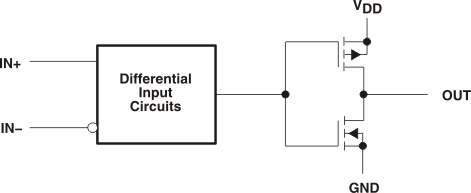SGLS156F March 2003 – December 2016 TLC3702-Q1
PRODUCTION DATA.
- 1 Features
- 2 Applications
- 3 Description
- 4 Revision History
- 5 Pin Configuration and Functions
- 6 Specifications
- 7 Parameter Measurement Information
- 8 Detailed Description
- 9 Application and Implementation
- 10Power Supply Recommendations
- 11Layout
- 12Device and Documentation Support
- 13Mechanical, Packaging, and Orderable Information
Package Options
Refer to the PDF data sheet for device specific package drawings
Mechanical Data (Package|Pins)
- D|8
- PW|8
Thermal pad, mechanical data (Package|Pins)
Orderable Information
1 Features
- Qualified for Automotive Applications
- AEC-Q100 Qualified With the Following Results:
- Device Temperature Grade 1: –40°C to +125°C Ambient Operating Temperature Range
- Device HBM ESD Classification Level H2
- Devce CDM ESD Classification Level C4B
- Push-Pull CMOS Output Drives Capacitive Loads Without Pullup Resistor, IO = ± 8 mA
- Very Low Power…100 µW Typical at 5 V
- Fast Response Time… tPLH = 2.7 µs Typical With 5-mV Overdrive
- Single-Supply Operation…3 V to 16 V
- On-Chip ESD Protection
2 Applications
- Transmission Control Unit
- Braking
- Engine Control
3 Description
The TLC3702-Q1 consists of two independent micro-power voltage comparators. Compared to similar devices, the TLC3702-Q1 uses one-twentieth of the power for similar response times. This allows the device to react quickly to fast changing signals while extending the battery life.
The push-pull CMOS output stage drives capacitive loads directly without a power consuming pullup resistor to achieve the stated response time. Eliminating the pullup resistor not only reduces power dissipation but also saves board space and component cost. Additionally, the output stage is fully compatible with all TTL and CMOS logic requirements.
Texas Instruments’ LinCMOS™ process offers superior analog performance versus standard CMOS processes. Along with the standard CMOS advantages of low power without sacrificing speed, high input impedance and low bias currents, the LinCMOS process offers extremely stable input/offset voltages with large differential input voltages. This characteristic makes it possible to build reliable CMOS comparators.
The TLC3702-Q1 has a wide supply range from 3 V to 16 V, allowing design flexibility. The voltage range also allows the device to handle start-stop applications and be connected directly to a standard 12-V battery. All of these features make the TLC3702-Q1 suitable for HEV/EV and powertrain system such as transmission control unit (TCU) and engine control.
Device Information(1)
| PART NUMBER | PACKAGE | BODY SIZE (NOM) |
|---|---|---|
| TLC3702-Q1 | SOIC (8) | 4.90 mm × 3.91 mm |
| TSSOP (8) | 3.00 mm × 4.40 mm |
- For all available packages, see the orderable addendum at the end of the data sheet.
Symbol (Each Comparator)

Functional Block Diagram (Each Comparator)
